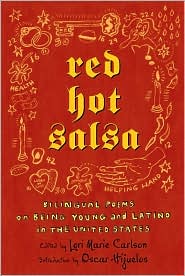
This book was a pretty fast read. Unlike The Poet Slave of Cuba, Red Hot Salsa used a variety of poems to give a clear picture of how life is for young children of Latin decent. I thought it was neat how they placed the poems in English first and then in Spanish. The poems also had a mixture of English and Spanish words which caused me to get lost in the language, but I was able to determine some words by placing them in the context. This a great book for Bilingual or ESL students who are learning the English language because they have the poems in both English and Spanish to help learn the words.
Each poem does a great job telling readers about the culture, any judgements, emotions, and challenges faced by children from a different culture. The poem “I Am Who I Am, So What” (pp.16-17) explains the character’s mood of being a Latino in the United States very well. The poet uses the two phrases, “not Mexican enough, not American enough” to help the readers feel the character’s sense that they do not belong to either country. Do any of today’s students feel that they are not accepted by people or belong to those of their own kind as well as their friends? Are they judged for being who they are?I like how many poems are just nice poems about the world and experiences everyone deals with, such as the poem about eyes on pages 56-57 and the short poem called “Upon Knowing You” on page 70. It is excellent how they have a glossary in the back to help readers understand the Spanish words used in each poem. One question, though. What is up with the poem on page 60?
Each poem does a great job telling readers about the culture, any judgements, emotions, and challenges faced by children from a different culture. The poem “I Am Who I Am, So What” (pp.16-17) explains the character’s mood of being a Latino in the United States very well. The poet uses the two phrases, “not Mexican enough, not American enough” to help the readers feel the character’s sense that they do not belong to either country. Do any of today’s students feel that they are not accepted by people or belong to those of their own kind as well as their friends? Are they judged for being who they are?I like how many poems are just nice poems about the world and experiences everyone deals with, such as the poem about eyes on pages 56-57 and the short poem called “Upon Knowing You” on page 70. It is excellent how they have a glossary in the back to help readers understand the Spanish words used in each poem. One question, though. What is up with the poem on page 60?


